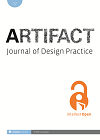-
oa Urban experiments exhibited: Exploring practice-based design research and agency in urban space
- Source: Artifact, Volume 9, Issue 1-2, Dec 2022, p. 26.1 - 26.26
-
- 15 Mar 2022
- 30 Sep 2022
- 23 Jan 2023
Abstract
This article explores the methodological considerations regarding the organization of a site-specific exhibition in urban space and the design research experiments that may be part of such an exhibition. The aim is to encourage design research as ‘exhibition’ and to propose a format that allows theory to enter the exhibition programme for the purpose of aligning exhibition contributions with theoretical contributions. Through the proposed analytical approach, we offer a method and a model to analyse interventions in public space in relation to agency and the participatory agenda for humans and non-humans. The main contribution is an exploration of the specificalities of curating an exhibition in urban space as a distinct practice-based design research project, where programme, research questions and experiments create knowledge on scaling agency in regard to temporality, citizenship and the value of urban space.



